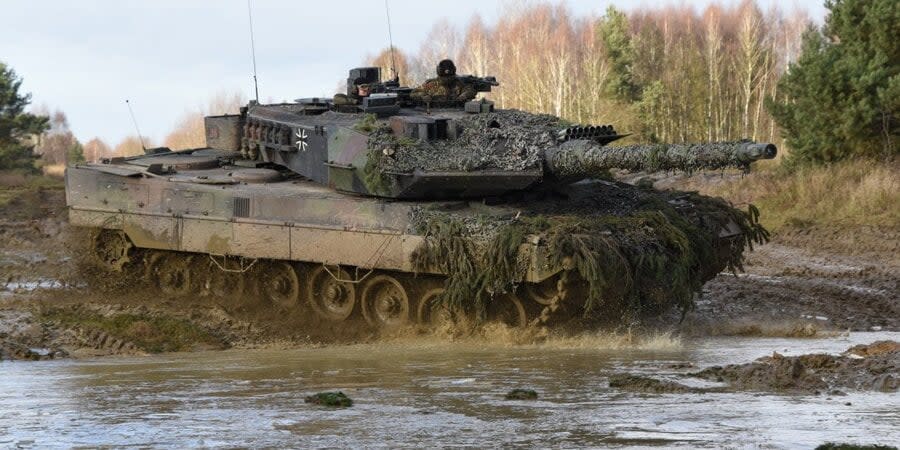How Western tanks will help Ukraine, what Gerasimov's new attempts to justify war mean

- Oops!Something went wrong.Please try again later.
ISW summarizes preliminary data on the possible supply of tanks to Ukraine by a coalition of NATO member states:
The United States is probably preparing to send a "significant number" of Abrams M1 tanks to Ukraine, the White House may announce this decision as early as Jan. 25 (according to U.S. newspaper the Wall Street Journal);
Germany may supply at least one tank company (14 tanks) of Leopard 2 tanks at an unspecified date (according to German news magazine Der Spiegel).
Poland is likely to send Leopard 2 tanks to Ukraine after Germany's official authorization.
The United Kingdom is preparing to send 14 Challenger 2 tanks to Ukraine;
France’s Emmanuel Macron suggested that he would supply French Leclerc tanks to Ukraine (the number is not yet specified).
As a result, the provision of combat tanks to Ukraine by Western countries will help the Ukrainian army to conduct mechanized combat operations to defeat the Russian invasion forces and liberate Ukrainian territory, ISW analysts say.
Read also: Germany approves transfer of Leopard tanks to Ukraine, Spiegel reports
They emphasize that so far, the West's delay in this matter has not allowed Ukraine to take advantage of the fact that Russian forces are confined to Bakhmut. Taking advantage of this situation, Ukrainian forces could slowly deploy or preserve the weapons and supply systems necessary for large-scale counteroffensive operations.
As early as December 2022, Ukrainian Commander-in-Chief Valerii Zaluzhnyi stressed that Ukraine needed 300 battle tanks (among other weapons systems) to launch a counteroffensive.
Chief of the Russian General Staff Valery Gerasimov has supported Russian dictator Vladimir Putin's attempts to present the war unleashed by Russia against Ukraine in the context of the events of the Second World War. On Jan. 23, Gerasimov said that "modern Russia has never known such a level and intensity of hostilities" and that Russia was allegedly opposed by the entire collective West, so mobilization was needed.
He also stated that the Russian General Staff had used the mobilization plan to stabilize the situation, protect Russia’s “new territories” (Ukrainian land currently under Russian military occupation) and conduct offensive actions.
Read also: Gerasimov fires key general in attempt to bolster his personal authority — UK intelligence
At the same time, Gerasimov noted that such measures have not been taken since the “Great Patriotic War" (Russia’s name for the Second World War, but referring only to the period of 1941 to 1945, to obscure the Soviet Union’s earlier alliance with Nazi Germany).
He hinted that the current war allegedly poses the greatest threat to Russia since then, which is why a command of the Russian invasion force in Ukraine under Gerasimov himself as Chief of the General Staff is needed.
The Institute believes that with such statements, the Russian authorities are trying to justify to Russian society the continued need for constant sacrifice and mobilization. The second reason for such rhetoric is the Russian General Staff's attempt to counteract the influence of Wagner PMC financier Yevgeny Prigozhin and Chechen warlord Ramzan Kadyrov, as well as their paramilitary structures, which threaten Gerasimov himself and the Russian General Staff.
ISW notes contradictory reports about the appointment of generals in the Russian army: Colonel General Sergei Kuzovlev as commander of Russia’s Southern Military District, and Lieutenant General Yevgeny Nikiforov as commander of the Western Military District (RBC news agency citing Defense Minister Sergei Shoigu's decision).
Read also: What are Kremlin's plans for 2023? ISW analyzes possible war scenarios
At the same time, the UK Ministry of Defense and the Defense Intelligence of Ukraine previously reported that Nikiforov and Kuzovlev had been reassigned to several positions of commanders of various districts. The experts conclude that the command structure of the military districts in the Russian army remains opaque.
In turn, this indicates that the Russian armed forces are trying in vain to create reliable management structures and maintain the traditional command structure, analysts concluded.
Other conclusions of ISW analysts over the past day:
Russian forces continued limited counterattacks along the Svatove-Kreminna line and Ukrainian forces reportedly continued counteroffensive operations near Kreminna;
Russian forces continued to conduct ground attacks in the Bakhmut and Avdiyivka-Donetsk City area. Russian forces made marginal territorial gains near Bakhmut;
Russian sources claimed, likely to distract from the lack of progress in Bakhmut, that Russian forces launched an offensive around Vuhledar;
Russian forces likely continued to conduct limited and localized ground attacks in Zaporizhzhya Oblast but likely did not make territorial gains, further undermining Zaporizhzhya Oblast occupation official Vladimir Rogov’s prior territorial claims;
Ukrainian special forces conducted a raid across the Dnipro River in Kherson Oblast on Jan. 23-24;
the Russian authorities are likely to continue their efforts to mobilize ethnic minorities to participate in the fighting in Ukraine;
Russia’s defense industrial base is reportedly increasing the production of drones and loitering munitions;
Ukrainian partisans targeted a member of the Zaporizhzhya occupation “administration”.
Battle map: the battle for Bakhmut and Soledar, fighting in Donbas, southern and northeastern Ukraine
Read the original article on The New Voice of Ukraine

